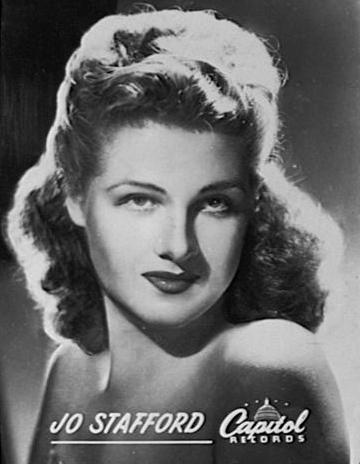Jo Stafford, who died yesterday, is mostly forgotten now, save by those who were young a half-century ago, but back then she was one of the most popular singers in America, a wholesome beauty with a smooth, perfectly produced voice who sold millions and millions of records. Some of them were silly novelties, others bland period ballads, but when she had a good song to sing, nobody sang it better.
Stafford dealt in reassurance, a commodity much appreciated during World War II and in the Age of Anxiety that followed it, which may explain why she is not nearly so well remembered as Frank Sinatra (with whom she sang in Tommy Dorsey’s band) or the hotter, sexier canaries of the Fifties. Her tasteful singing was rhythmically fluid without ever sounding self-consciously “jazzy,” and her warm mezzo-soprano voice had a maternal quality that eased the troubled heart, though it didn’t do much for the critics of the day. “I never made it with the critics,” she once told Gene Lees. “I think what the critics didn’t like was that it was simply singing.”
 Stafford went into semi-retirement in 1966. By then most of her records were out of print, and when I wrote a piece for Mirabella in 1994 occasioned by the release of a three-CD box set of her old Columbia recordings, she was very much a figure of the past. That hasn’t changed. Most of the collections of her singles that are currently available are junky hit-oriented anthologies that give no sense of what she was like at her best. Fortunately Corinthian, her own label, put out two excellent CDs, Big Band Sound and Jo + Jazz, in which she sings blue-chip standards accompanied by some of the greatest jazz and pop instrumentalists of the Swing Era. Jazz musicians loved Stafford’s voice and knew her worth–Lester Young was one of her biggest fans–and were always glad to play for her.
Stafford went into semi-retirement in 1966. By then most of her records were out of print, and when I wrote a piece for Mirabella in 1994 occasioned by the release of a three-CD box set of her old Columbia recordings, she was very much a figure of the past. That hasn’t changed. Most of the collections of her singles that are currently available are junky hit-oriented anthologies that give no sense of what she was like at her best. Fortunately Corinthian, her own label, put out two excellent CDs, Big Band Sound and Jo + Jazz, in which she sings blue-chip standards accompanied by some of the greatest jazz and pop instrumentalists of the Swing Era. Jazz musicians loved Stafford’s voice and knew her worth–Lester Young was one of her biggest fans–and were always glad to play for her.
Stafford was only a vague memory of my childhood when a septuagenarian friend of mine played me a Columbia 78 of her version of “Early Autumn” a decade and a half ago. (It’s on Big Band Sound, and you can also download it from iTunes.) The record, arranged by her beloved husband Paul Weston, couldn’t be simpler. Stafford is accompanied by a clarinet choir and a soft-spoken rhythm section, and she sings Johnny Mercer’s haunting lyric in the most direct and unmannered way imaginable:
There’s a dance pavilion in the rain
All shuttered down
A winding country lane
All russet brown
A frosty window pane
Shows me a town grown lonely.
That deceptively uncomplicated-sounding performance hit me with the force of revelation. All at once I knew that good old Jo Stafford was a great artist, and I resolved to spread the word about her artistry in any way I possibly could. A couple of years later I wrote about her in Mirabella, and after that I made a point of mentioning Stafford whenever I had occasion to write about golden-age popular song and its interpreters, but never again did I have occasion to write a full-length piece about her. I wish I had, and I wish I’d sent it to her while she was still alive. Perhaps she would have enjoyed knowing that her quiet, unpretentious art was still giving pleasure long after her fame had faded.
* * *
UPDATE: The Daily Telegraph, Los Angeles Times, New York Sun, New York Times and Washington Post now all have long, well-informed obituaries.
Chris Albertson passes along this snippet from an interview he did with Lester Young in 1958.
YOUNG You know, I can tell you this, really, my favorite singer is Kay Starr. No, that’s the wrong name. What’s that other lady’s name? Her husband has a band.
ALBERTSON It’s not Jo Stafford?
YOUNG There you are! Yeah, I’ll go there.
ALBERTSON Jo Stafford is your favorite singer?
YOUNG Yeah, and Lady Day [Billie Holiday]. And I’m through.
ALBERTSON But Jo Stafford does not sing jazz, does she?
YOUNG No, but I hear her voice and the sound and the way she puts things on.
Enough said.
* * *
Jo Stafford sings “The Gentleman Is a Dope,” by Richard Rodgers and Oscar Hammerstein II, in an undated TV performance:
